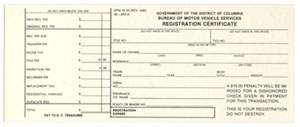1984 Capital City Baseplate
Issued October 1984 Through August 1991; Used Until April 2016
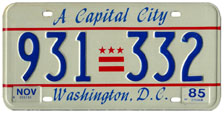 |
 |
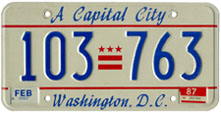 |
1984 |
1985 |
1986 |
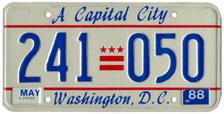 |
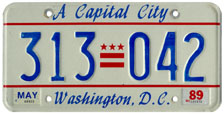 |
1987 |
1988 |
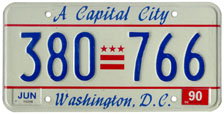 |
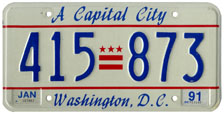 |
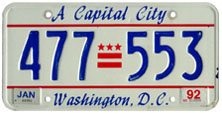 |
1989 |
1990 |
1991 |
Just the Facts... |
|
Construction |
6" x 12", aluminum covered with reflective white sheeting. Issued in pairs. |
Design |
Red graphics: two horizontal stripes and the D.C. flag in the center. |
Period of issuance |
Approximately 7 years: October 1, 1984, through sometime in August 1991 (although issuance may have ceased in late July 1991). |
Period of use |
Thirty-one years and seven months: October 1, 1984, through April 2016 |
Non-passenger plates |
Examples of a number of types issued on the 1984 baseplate are pictured below. |
Other facts |
All plates of this base were issued under the staggered system and should therefore include both a month and year sticker. Earliest expiration is likely OCT 85. |
Capital City baseplates were introduced for both new registrations and renewals on October 1, 1984. This is the last base that was used for a (complete) general reissuance, and they could have been used until spring 2016 if properly revalidated, making them longest-used license plates in District of Columbia history. Click here to see images of 1984 baseplates that were still in use as of 2010.
Plates of this base include no permanent year designation. They are numbered from 925-001 through 999-999, then 010-001 through 501-750. The earliest plates, 925-001 through at least 937-041, have bolt slots, whereas by 947-405 a change had been made to holes. Security marks (a.k.a. holograms ) were introduced on this base, but the earliest plates do not have them. The lowest reported plate with an example of the first mark, “DC 86”, is 164-958, which was issued in August 1986, and number 313-042 has the same mark. Other marks are “DC 87," seen on plate 380-766; “DC 89” on no. 472-172; and “DC 90” on no. 480-752.
The practice of having the final three digits of the serial number of stickers applied to plates issued in conjunction with new registrations match the final three digits of the plate number ended in mid-1987. The initial expiration of the latest plate that we have seen with a matching year sticker is May 1988, which is evidence of a registration issued in May 1987.
The following reflective stickers were issued to validate 1984 baseplates:
Marked |
Colors |
Period of Issuance |
85 |
blue on white |
Oct. 1-Dec. 31, 1984 |
86 |
red on white |
1985 |
87 |
white on red |
1986 |
88 |
white on blue |
1987 |
89 |
red on white |
1988 |
90 |
white on red |
1989 |
91 |
blue on white |
1990 |
92 |
red on white |
Jan. 1-August 1991 |
Later stickers were used to revalidate plates of this base until the issuance of plate stickers ceased in 2002.
1984-91 Registration Numbers
Our assumptions as to general-issue passenger car registration numbers assigned while the 1984 baseplate was being issued are presented in this table. Note that, as discussed below, older plates associated with existing registrations were replaced with Capital City plates between October 1984 and September 1986, which accounts for the higher than normal quantity of plates issued during 1985 and 1986.
Period of Issuance |
Sticker Marked |
Estimate of Numbers Assigned |
Quantity of Estimated |
Oct.-Dec. 1984 |
85 |
925-001 to 940-000 |
15,000 |
1985 |
86 |
940-001 to 999-999 010-001 to 100-000 |
60,000 90,000 |
1986 |
87 |
100-001 to 220-000 |
120,000 |
1987 |
88 |
220-001 to 290-000 |
70,000 |
1988 |
89 |
290-001 to 353-000 |
63,000 |
1989 |
90 |
353-001 to 413-000 |
60,000 |
1990 |
91 |
413-001 to 481-000 |
68,000 |
Jan.-Aug. 1991 |
92 |
481-001 to 501-750 |
20,750 |
 |
||
Parked at a stately brick home in the 1800 block of Randolph St., NW, are consecutively-numbered 1984 baseplates. The zero prefix, although not a formal designation, generally indicates that the plates were issued in the mid-1980s to replace older plates rather than in conjunction with the issuance of a new registration. Therefore, to the trained observer these plates indicate that the vehicle's owner is a long-time Washington resident. Click on the images below to see close-up views of the old plates. |
||
Click here to see images of a few of the 1984 baseplates that were still being used as of 2010.
D.C.'s Last General Reissuance
All valid plates (1974 and 1978 baseplates) were replaced with 1984 baseplates during a two-year period. Beginning in October 1984, motorists whose plates were numbered from 100-001 through 399-999 (i.e. the oldest 1974 plates) received plates of the new design upon expiration of their registration between October 1984 and September 1985. Motorists with plates numbered 400-000 and higher, as well as those with personalized registrations, received new plates as they renewed from October 1985 through September 1986. Therefore the latest month/year sticker combination that could appear on any 1974 or 1978 baseplate is SEP 86.
It has been reported that Capital City baseplates numbered from 925-001 through 999-999 were issued only for new registrations, and that plates numbered beginning at 010-001 were used for the general reissuance (i.e. to replace older plate of motorists with existing registrations). This has not been confirmed.
Before it began, the estimated cost of the reissuance was $670,000. There were “about 300,000 registrations in the District” at the time, according to a Washington Post article, and about 20,000 registrations were renewed every month. Both statistics are thought to include registrations of all types, not just private passenger.
About the Capital City Design
This baseplate's design took a long and winding path before winding up similar to previous bases. After a Washington newspaper columnist called for new plates, probably in late 1981, a design contest was held by the City Hall New Times, a newspaper published by the city's government. More than 200 entries were received, and the winner was selected by a blue-ribbon commission created and chaired by Mayor Marion Barry. The design, with three red stars across the top and two wide bands across the center on a white background, collectively representing the District's flag, was created by James L. Moseley. The registration number was light blue, and Nation's Capital and Washington, D.C. were in their familiar locations between the upper and lower bolt holes, respectively. Mr. Moseley was congratulated by Mayor Barry upon the design's unveiling in February 1982, although the mayor quickly added that the slogan might “be changed to something snappier before the plate goes into circulation, probably in March 1983,” according to a Washington Post article.
The new plates were not issued in early 1983; and, as we now know, were in fact never made. It was not until August 1984 that Mayor Barry unveiled the District's next plates, the 1984 Capital City base. The design chosen 2½ years earlier had subsequently been rejected because the numbers were not sufficiently visible at a distance. According to a DMV administrator, its creator, Mr. Moseley, still received the contest prize: free registration for one year. “We want to publicize [the District] as a capital city, not just the nation's capital,” said Mayor Barry upon announcing the Capital City design. “I thought it was time for a change psychologically,” said the mayor.
Retirement
In early April 2016 a letter was sent by the DMV to each individual to whom a valid six-number registration was still assigned, including numbers displayed on both Capital City and Celebrate & Discover plates, informing them that their plates were being replaced. Flat plates of the then current style but with each registrant's long-held number had been made, and their owners were asked to bring their old plates to the DMV on one of the following three Mondays to make the exchange. The DMV, while closed to the public for routine business on Mondays, typically uses these days for non-routine work such as replacing reserved-number plates annually in the spring. Witness accounts indicate that on the designated Mondays in April (presumably April 11, 18, and 25), DMV employees were in their parking lot to assist motorists as they replaced their old plates with the new ones. Vehicle owner were allowed to keep their old plates.
The letter used by the DMV to summon affected motorists to their office for replacement plates reportedly indicated that the project was being undertaken due to the faded and deteriorated condition of many six-digit plates, the oldest of which had been in use for more than 37 years. That these long-time D.C. residents were given their same number on new plates indicates that this effort was not intended to get the obsolete-format numbers off the road in the interests of having all valid registrations be of the same format (AB-1234), which DMVs sometimes do. In these instances, motorists are sometimes allowed to retain their original number if they're willing to transfer it to personalized status and pay the corresponding fees but this did not happen in this case because the old six-digit numbers now displayed on new flat plates are still treated as regular registrations.
An image of one of the flat six-digit plates appears in the section of our 1991 baseplate page in which this change is discussed. Because drivers were allowed to keep their old plates it's possible that some switched back to them after leaving the DMV. However, based on what we've learned about this April 2016 program all six-number plates should have been removed from service at that time (although the process likely extended into May).
Envelopes in which registration certificates and plate stickers were mailed typically included a graphic image of a plate in order to show where stickers were to be placed. The graphic of the earliest envelopes made after the 1984 baseplate was introduced, an example of which is shown above, has three readily identifiable errors: The slogan is incorrect, the graphic is incorrect (an inappropriate holdover from the previous base), and there is no month sticker placement element. These errors were corrected on the later 1984 base envelope design (below), but one sticker guide arrow was inadvertently omitted. Aside from the graphics these envelopes are essentially identical: click on the image above for a view of the entire envelope. |
||
 |
||
Most notable is the difference in the vertical space between the two rules, which is 3" on the lower plate and 3-5/16" on the top plate. Other differences in the appearance of these plates result from the different position of these prominent features. These plates are not a pair. That they both are comprised of six letters, the first of which is G, is a coincidence. Neither plate includes a security mark in the sheeting. The top plate, marked GRNNTL, is pictured below. |
1984 Baseplate Types
Only types of which we have found examples are pictured. Images of plates of additional types will be added to this array as they become available.
 |
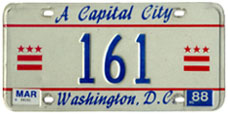 |
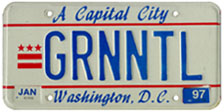 |
Passenger - General-Issue |
Pass. - Reserved Number |
Pass. - Personalized |
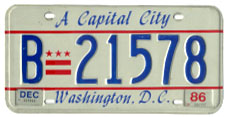 |
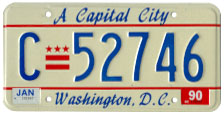 |
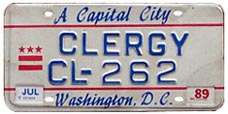 |
Bus |
Commercial (Truck) |
Clergy |
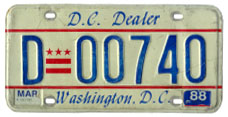 |
 |
 |
Dealer |
D.C. Government |
Hire (Taxi) |
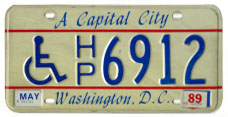 |
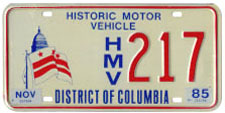 |
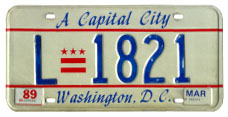 |
Handicapped Person |
Historic Motor Vehicle |
Livery |
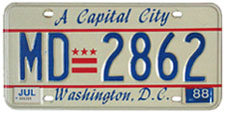 |
 |
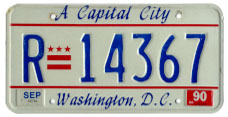 |
Medical Doctor |
Motorcycle |
Rental |
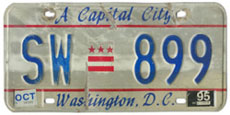 |
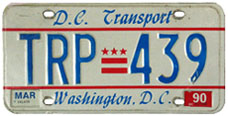 |
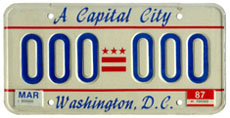 |
Solid Waste |
Transport |
Sample |
|
This page last updated on December 31, 2017 |
 |
|
copyright 2006-2018 Eastern Seaboard Press Information and images on this Web site may not be copied or reproduced in any manner without consent of the owner. For information, send an e-mail to admin@DCplates.net |














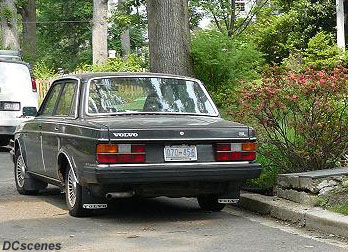
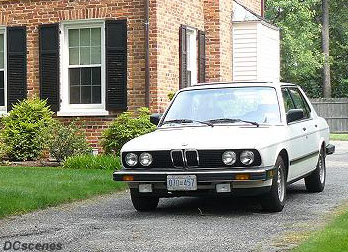

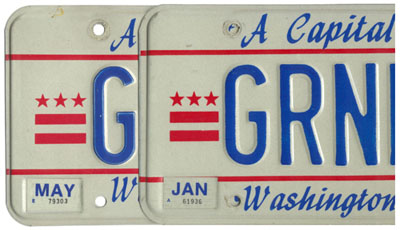 Although 1984 base general-issue passenger plates, which have the flag graphic in the center, were made with reflective sheeting with graphics printed by 3M Corp., many plates that feature the flag in an alternative position were made with plain white sheeting that had the non-embossed features manually silk-screen printed. These two personalized plates illustrate variances that may be found in these "non-graphic" graphic plates.
Although 1984 base general-issue passenger plates, which have the flag graphic in the center, were made with reflective sheeting with graphics printed by 3M Corp., many plates that feature the flag in an alternative position were made with plain white sheeting that had the non-embossed features manually silk-screen printed. These two personalized plates illustrate variances that may be found in these "non-graphic" graphic plates.